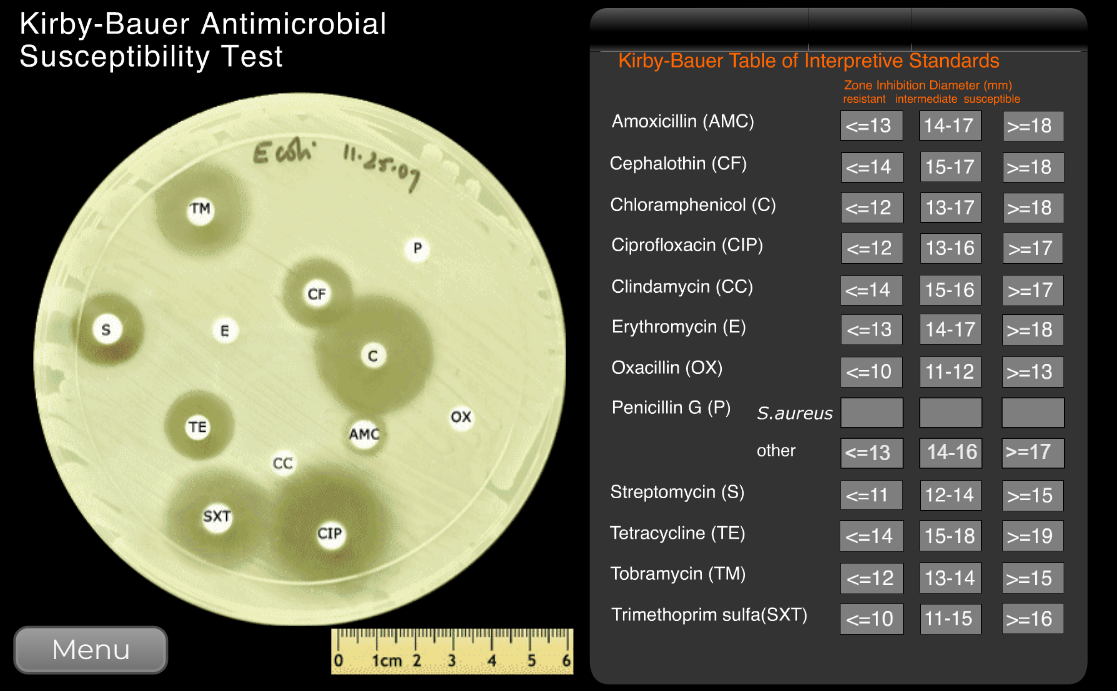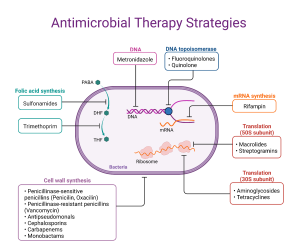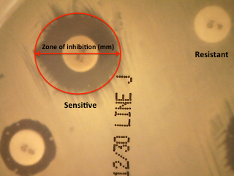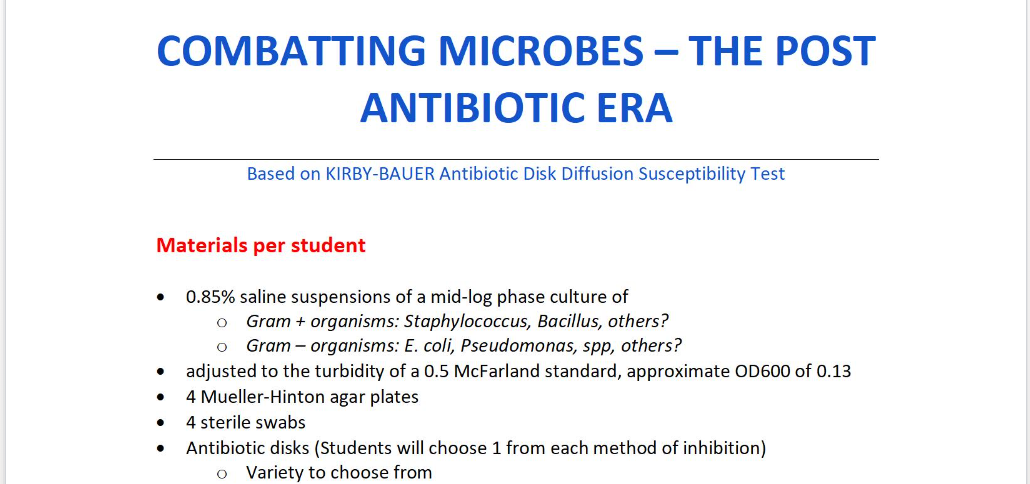Modules – Skills & Tools
Combatting Microbes- Antibiogram
Background Information
WHY YOU SHOULD CARE ABOUT: Combatting Microbes
Although very few species of microbe are pathogens, sometimes we need to aggressively combat growing microbes to prevent disease and death. Antibiotics, chemicals, antiseptics and disinfectants are used preventatively to keep our environment clean and prevent growth and spread of pathogens.
There are many ways to combat microbial growth, including biological, physical, mechanical and chemical means. Many of these methods have been utilized by humans for thousands of years, including fermentation (drop in pH), or curing and sugar preservation (increased osmotic pressure). We control microbial growth daily, whether it is by brushing teeth, cleaning the toilet with bleach or cleaning a scrape with iodine.
- Slowing and reducing growth: Low/High sugar or acid, Starve of nutrients.
- Damage cell wall: Certain antibiotics, heat, high pressure
- Coagulate proteins: Heat, high pressure, ethanol
- Lysing cell membranes: detergent
- Interfere with metabolic processes, protein production: Certain antibiotics
HOWEVER, the global indiscriminate and overuse of antimicrobials for humans, pets and for agriculture causes more harm than good. The occurrence, spread and rapid increase in multi-drug resistant pathogens is alarming. If you want to know more about this topic you can take MCB 4271 Antimicrobial Resistance with Dr. Czyz in our department.
Access OpenStax:
13.1 Controlling Microbial Growth
14.1 History of Chemotherapy and Antimicrobial Discovery
14.6 Testing the Effectiveness of Antimicrobials
4.3 Nonproteobacteria Gram-Negative Bacteria and Phototrophic Bacteria
Learning Objectives:
After completing this module, students will be able to:
- Recall new vocabulary and definitions that pertain to this module.
- Describe antibiotics and outline how different classes of antibiotics work.
- Perform a Kirby-Bauer Diffusion test (=antibiogram) and compare microbial sensitivity to three antibiotics.
- Discuss antimicrobial resistance and global problems.
- Debate antibiotic stewardship.
- Look at plant based antimicrobial compounds (Pharmacognosy, Ethnobotany)
- Understand that lot of antibiotics/antimicrobials are chemicals produced by bacteria and fungi to defend themselves
History Connection
Check out what type of different products Listerine, named after Dr. Lister, produces today: https://www.listerine.com/products
The Nobel Prize in Physiology or Medicine 1945 was awarded jointly to Sir Alexander Fleming, Ernst Boris Chain and Sir Howard Walter Florey. “for the discovery of penicillin and its curative effect in various infectious diseases.” I took photo below in Oxford at the Museum of the history of science a few years ago. This is the original vial where penicillin was isolated for the first time in 1939, just in time to use it for wounded solders in WW2.
The antimicrobial resistance test, also called Kirby Bauer method, was originally published in 1966 (Bauer AW, Kirby WM, Sherris JC, Turck M. Antibiotic susceptibility testing by a standardized single disk method. Am J Clin Pathol. 1966 Apr;45(4):493-6. PMID: 5325707)
Kirby Bauer 1966.pdf
Case Study
Just a Spider Bite? Antimicrobial Resistance and Susceptibility
and
How can plants help us to fight microbes and antimicrobial resistance?
Watch this seminar/talk by Cassandra Quave and explore the many facets of ethnobotany and how it is and has been an integral part of fighting infectious diseases
more info…
Chassagne, F., T. Samarakoon, G. Porras, J.T. Lyles, M. Dettweiler, L. Marquez, A.M. Salam, S. Shabih, D. Raschid Farrokhi, C.L. Quave. (2021). A Systematic Review of Plants with Antibacterial Activities: A Taxonomic Perspective. Frontiers in Pharmacology 11 (2069) doi: 10.3389/fphar.2020.586548
Porras, G., F. Chassagne, J.T. Lyles, L. Marquez, M. Dettweiler,A.M. Salam, T. Samarakoon,S. Shabih, D. Raschid Farrokhi, and C.L. Quave. (2021) Ethnobotany and the Role of Plant Natural Products in Antibiotic Discovery. Chemical Reviews 121, 6, 3495-3560. http://dx.doi.org/10.1021/acs.chemrev.0c00922
Virtual Lab Simulations
Virtual Activity: Kirby-Bauer Antimicrobial Susceptibility Test
Think about the mode of action of the antibiotics and how they vary between Gram- and Gram + organisms
Online Lab
Activity: Perform Kirby-Bauer Assay
Lab Kit Materials for this Activity
- Bacterial Cultures: E. coli, M. luteus
- 10mL sterile PBS (x2)
- McFarland Standard
- Cotton-tip swabs
- Steel forceps
- Penicillin Antibiotic Disks – “Pen” (x2)
- Tetracycline Antibiotic Disks – “T” (x2)
- Blank disks – “Blank” (x4)
- Ruler
Video Tutorials
Kirby-Bauer Assay
Procedure
- Dilute each culture by transferring a few colonies from the original plate into to one of the PBS tubes using a sterile loop. Shake vigorously to suspend the cells.
- Compare the turbidity of your culture with the 0.5 McFarland standard. The density of the cells should be in that range.
- Do the same thing for your second culture.
- Label 2 Mueller Hinton agar plate with your initials, the date, the agar type, and the species name (1 plate for each organism)
- Take one sterile swab and dip it into one of the cultures.
- Inoculate the plate with the swab by making a zig zag pattern across the entire plate.

- Repeat these three other times, rotating the plate 90° each time. You want the entire plate covered with bacteria.
- Using your forceps, take one antibiotic disk and place in different parts of the plate. The name and concentration of the antibiotics is on the disk
- Dip the 2 sterile disks without antibiotic in any antimicrobial substance of your choice (like essential oil, mouthwash etc) and place them in another part of the plate.
- Repeat 6-9 for your second organisms
- Incubate the plate for 48 hours.
- Measure the zone of inhibition for each antibiotic and natural product.
- Evaluate the action as “sensitive” “intermediate” or “resistant”
Results
Measure the zone of inhibition for each disk in mm using your ruler
Evaluate the results for your antibiotic disk and explore the performance standards for this assay mandated by regulatory bodies https://clsi.org/media/pmqdfjfh/m02ed14e_sample.pdf
Compare how the different microbes are affected by the antibiotics, explain the mechanism of action of the antibiotics and the household item you used.
In-Person Lab
Activity: Combatting Microbes
Resources
Take a look at the appropriate module for the vocabulary that is being tested: Microbiology @ UF Lab Terminology Quizlet
- BBL Sensi Disk abbreviation and concentration chart
- BBL Sensi Disk Zone Diameter Interpretive Chart
- and https://commerce.bio-rad.com/webroot/web/pdf/inserts/CDG/en/66098_2020_05_EN.pdf
- Use the Gideon website or app to learn about the different antibiotics, their function and use.
- For the antibiogram we also use essential oils or other natural products, check out this plant profiler from Natural Medicine exploring the antimicrobial (and other properties) of a large variety of plants.
- Fighting Food-borne Pathogens with Natural Antimicrobials
- Watch this incredible video to see how antibiotic resistance evolves in front of your eyes. Watch antibiotic resistance evolve. Science News





